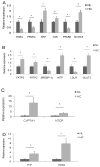Alteration of hepatic nuclear receptor-mediated signaling pathways in hepatitis C virus patients with and without a history of alcohol drinking
- PMID: 21898497
- PMCID: PMC3230737
- DOI: 10.1002/hep.24645
Alteration of hepatic nuclear receptor-mediated signaling pathways in hepatitis C virus patients with and without a history of alcohol drinking
Abstract
The current study tests a hypothesis that nuclear receptor signaling is altered in chronic hepatitis C patients and that the altered pattern is specific to alcohol drinking history. The expression of a panel of more than 100 genes encoding nuclear receptors, coregulators, and their direct/indirect targets was studied in human livers. Gene expression pattern was compared between 15 normal donor livers and 23 hepatitis C virus (HCV) genotype 1-positive livers from patients without a drinking history (matched for age, sex, and body mass index). HCV infection increased the expression of nuclear receptors small heterodimer partner and constitutive androstane receptor (CAR) as well as genes involved in fatty acid trafficking, bile acid synthesis and uptake, and inflammatory response. However, the expression of retinoid X receptor (RXR) α, peroxisomal proliferator-activated receptor (PPAR) α and β as well as steroid regulatory element-binding protein (SREBP)-1c was decreased in HCV-infected livers. Gene expression pattern was compared in chronic hepatitis C patients with and without a drinking history. Alcohol drinking increased the expression of genes involved in fatty acid uptake, trafficking, and oxidation, but decreased the expression of genes responsible for gluconeogenesis. These changes were consistent with reduced fasting plasma glucose levels and altered expression of upstream regulators that include RXRα, PPARα, and CAR. The messenger RNA levels of fibroblast growth factor 21, interleukin-10, and fatty acid synthase, which are all regulated by nuclear receptors, showed independent correlation with hepatic HCV RNA levels.
Conclusion: Our findings suggest that those genes and pathways that showed altered expression could potentially be therapeutic targets for HCV infection and/or alcohol drinking-induced liver injury.
Copyright © 2011 American Association for the Study of Liver Diseases.
Figures




References
-
- Kim WR. The burden of hepatitis C in the United States. Hepatology. 2002;36(5 Suppl 1):S30–4. - PubMed
-
- Manns MP, McHutchison JG, Gordon SC, Rustgi VK, Shiffman M, Reindollar R, et al. Peginterferon alfa-2b plus ribavirin compared with interferon alfa-2b plus ribavirin for initial treatment of chronic hepatitis C: a randomised trial. Lancet. 2001;358(9286):958–65. - PubMed
-
- Fried MW, Shiffman ML, Reddy KR, Smith C, Marinos G, Goncales FL, Jr, et al. Peginterferon alfa-2a plus ribavirin for chronic hepatitis C virus infection. N Engl J Med. 2002;347(13):975–82. - PubMed
-
- McHutchison JG, Lawitz EJ, Shiffman ML, Muir AJ, Galler GW, McCone J, et al. Peginterferon alfa-2b or alfa-2a with ribavirin for treatment of hepatitis C infection. N Engl J Med. 2009;361(6):580–93. - PubMed
Publication types
MeSH terms
Substances
Grants and funding
LinkOut - more resources
Full Text Sources
Medical
Molecular Biology Databases
